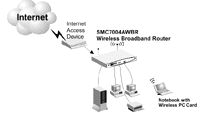
It is worth networking all the computers in a small office, or even home, unless perhaps the domestic machines are used only for games. Benefits include ease of access to any file or hard disc from an…
It is worth networking all the computers in a small office, or even home, unless perhaps the domestic machines are used only for games. Benefits include ease of access to any file or hard disc from any computer, convenient backups, and sharing Internet connections. Sharing software is feasible, but I feel is usually more trouble than it is worth for small systems.
For the average small office, isolated workgroup in a mill or a home/office, networking is fairly simple, although never so easy as Bill Gates suggests. Whether your network is wired or wireless, you should have an expert set up and administer large systems or anywhere that tight security is critical. Otherwise, a do-it-yourself approach works well.
How they work
Many incompatible networking systems and standards have been used over the 20 years or so that PC-compatibles have been networked, but today Ethernet is by far the dominant technology and the appropriate hardware is built-in to many new computers. Equipment is available from multiple vendors and all the currently popular operating systems support Ethernet, so no special software is required for small networks.
In most small wired networks, each computer is connected to a hub by a “Cat 5” flat cable with RJ45 plugs (similar to a phone wire, but with eight conductors). Each computer has a network interface card (NIC) or the equivalent hardware on the motherboard. The cards, cables and hub are inexpensive, so the whole system will cost under $100 per computer. Wired networks operate at 10 Megabits/second (Mbps) or, more common in recent systems, 100 Mbps. This is fast enough that it is not obvious to the user whether the hard disc being accessed is on the machine or elsewhere.
In wireless networks, each network card is a data transceiver, using 2.4 GHz radio waves, which is close to the frequency used by some cordless phones. The dominant wireless networking standard today is IEEE 802.11b, which will maintain a data transmission rate of 11 Mbps, if the radio signals are strong, but will drop back to as slow as 1 Mbps when the signal is weak, or there is interference. IEEE 802.11a is also used, because of its 54 Mbps speed, but is much less popular.
A cooperative effort by manufacturers, known as the Wireless Ethernet Compatibility Alliance (WECA) has developed a set of tight, widely used, standards, known colloquially as “WiFi”, which has resulted in relatively easy installation for users, even when hardware is from a variety of sources.
A few computers with wireless network cards can connect themselves, but even small networks usually have a hub, to extend range and interface with the wired network. Our hub is also a router for sharing an internet connection, and driving a printer, as shown in the figure.
Theoretically, we could have about 250 wireless connections to the hub but speed would be agonizingly slow. Connecting several computers this way is normally quite satisfactory.
The practical range of such a connection is a couple of hundred feet, at best, and may be much shorter in building with lots of metal.
More advanced systems can have thousands of computers, spread over larger areas, like the one at the University of Waterloo, where there are 22,000 students spread over an area a couple of kilometers in diameter.
Security
One problem with the excellent standardization of wireless networking mentioned above, is that if you do not take precautions, anybody with a wireless capable laptop can join you network, without your even being aware of it. The first step in security is to set the SSID, according to the instructions. If you do not, then access by others will be very easy. The instructions with the wireless network card should tell you how to implement Wired Equivalent protocol (WEP) which gives sufficient security for many people, but is far from solid. Many wireless network hubs are also routers, to facilitate sharing an Internet connection. Passwords should be set up for shared drives and the router. Leaving the default password is not a good idea. There is a good article, with discussion by users, at http://www.extremetech.com/article2/0,3973,9280,00.asp
Traveling with the network
While you may well fall into some networks, and may be able to browse the Internet or send e-mail at no charge, you are probably more interested in using networks intended to be available to the public. These require a monthly payment, but some allow “pay-as-you-go” usage, typically for around 50 cents Canadian a minute. This can become expensive entertainment, but is cheap for checking and sending Email, even with attachments. Some connection areas are in airports, and Starbucks is setting up wireless Internet connections in about 2000 coffee shops this year. Other companies offer services, but one problem is that most require monthly fees, so that moving around could become expensive.
Time will tell whether this service will take off. T-mobile.com advertises worldwide service, but actually have only two live spots in the UK, both London coffee shops. If they expand coverage, perhaps it will succeed, but I suspect they have to reduce prices too.
The future
Current standards will evolve rapidly, and security will probably improve. There is clearly an opportunity for nationwide providers of wireless access, with coverage like cell phones, or at least in major cities.
Print this page
